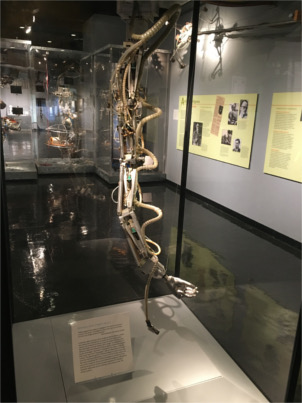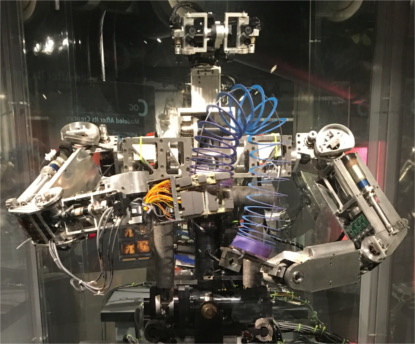

Clicking on images will get you a higher resolution image, if it is available.




I remember this arm hanging on the 9th floor of Tech Square (NE43).
This arm was supposed to play ping pong, and computer vision was
supposed to be solved over a summer to make that happen.
The MIT Mechanical Engineering Department folks I knew referred to it
as an arm designed by computer scientists: mechanically too complex,
and very difficult to control. The idea was that good AI would make up
for bad engineering. This misconception pervades a lot of
robotics, and keeps reappearing. In my view, machine intelligence
and learning does not make up for crappy hardware (at least not yet).
High quality robotics requires high quality engineering.
A related misconception is that biological hardware is crappy, so
there is an existance proof that intelligence can make crappy hardware
work. Unfortunately for this school of thought,
biological hardware is usually exquisitly suited for the organism's needs and
niche.
Chris Atkeson


I enjoyed programming these machines. Far more important than the machine
was the user interface. It was the first WIMP* interface I ever used.
When I became an MIT faculty member I included a $36,000 Symbolics Lisp
Machine in my startup package, because I thought I needed it to do
AI. However, by then the Sun workstations were pervasive
and provided Unix with GUIs,
so it was back to programming in C for me, especially for real time control
of robots.
Chris Atkeson
*WIMP = Windows, Icons, Menus and a Pointing device. A synonym for a graphical user interface (GUI). However, the term is sometimes used as a derogatory reference to a GUI by programmers who like to type commands on the command line. See command line and GUI. www.yourdictionary.com/wimp-interface




Above photos with yellow toy are from Nancy Pollard's thesis work.
Missing. Get some photos.



This robot is being abused. Its leg is jammed up into the body in a
way it never was when the robot was active. Imagine being trapped in
a glass case crouching and not being able to stretch your legs.
Forever.
CMU wants the robot back, and will take better care of it.
Chris Atkeson


CMU wants this robot back too. The land speed record for legged robots
has been broken.
Chris Atkeson


The quadruped robot in the video is in the lobby of Boston Dynamics.
Missing. Get photos.
Heavily influenced by CMU's direct drive arm. I have the links of this robot,
but the base and motors were too heavy to move when I left MIT.
Chris Atkeson
Chapter 1 of Direct Drive Robots: Historical Perspectives of Robot Design which describes 5 MIT direct drive arms.


This work was controversial, and made me think hard about our "scientific method": 1) How do we know if our robots "work"? 2) Do our robots work for the reasons we say they do (ideology), or because we are good at just making stuff work? Over the years, I have come to realize our standards in academic robotics are terrible (even mine). Most robots work because of details we don't talk about, and often don't think about, like the material properties of the rubber pads we put on fingertips or feet as an afterthought. This has been true of my own work on dynamic robots that juggle or walk.
The very successful iRobot Roomba was the descendent of this machine and
the ideas behind it. My understanding is that the original Roombas were
more ideologically pure, but current Roombas make world models, do SLAM
(Simultaneous Localization and Mapping), and plan.
Chris Atkeson







An early humanoid, which pioneered Series Elastic Actuators.
Intellectually, in addition to the subsumption architecture, Cog was supposed
to "develop" in a human-like way. This is a controversial position.
One argument is whether a robot should "develop" at all, or just be programmed.
A second argument is whether the cognitive development process should be
human-like or something else entirely. The current
enthusiasm for robot deep learning (Google "arm farm") suggests that
robots should develop, but not necessarily in human-like ways.
Chris Atkeson
Missing. Get photos. MIT WAM Catching Ball (Slotine)
Currently a successful robot business,
and a very influential robot. Lots of two WAM arm upper body robots
are out there, such as CMU's HERB.
Chris Atkeson




Currently a successful robot business,
and a very influential robot in both haptics and computer graphics/HCI.
Chris Atkeson


I left MIT in 1993, and some of this stuff happened at the MIT Media Lab, so I can't really comment on the rest of these robots. It is interesting that this exhibit is so AI Lab/CSAIL centric, and ignores what was/is going in Mechanical Engineering and other departments at MIT. Also, more recent stuff (post 2000?) is largely missing. DARPA Challenges. Hugh Herr's group at the Media Lab ... Not much on computer vision work at MIT either.






This work led to the social robot product Jibo.














No mention of Weizenbaum or Dreyfus (MIT critics of AI).
No mention of Perceptrons or Rosenblatt, whom MIT destroyed, and is now
vindicated by the dominance of neural network approaches to AI, which perhaps
is now more influential than the work descending from the "MIT school" of
AI.
Chris Atkeson






